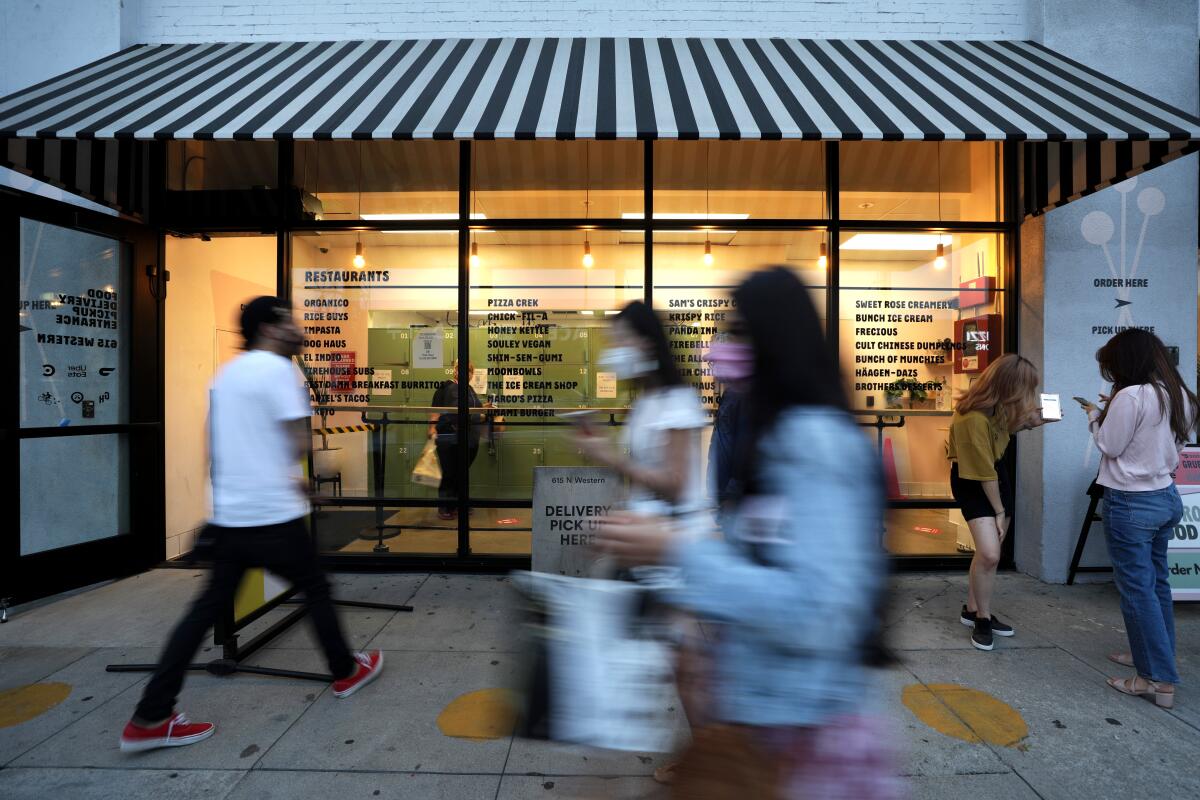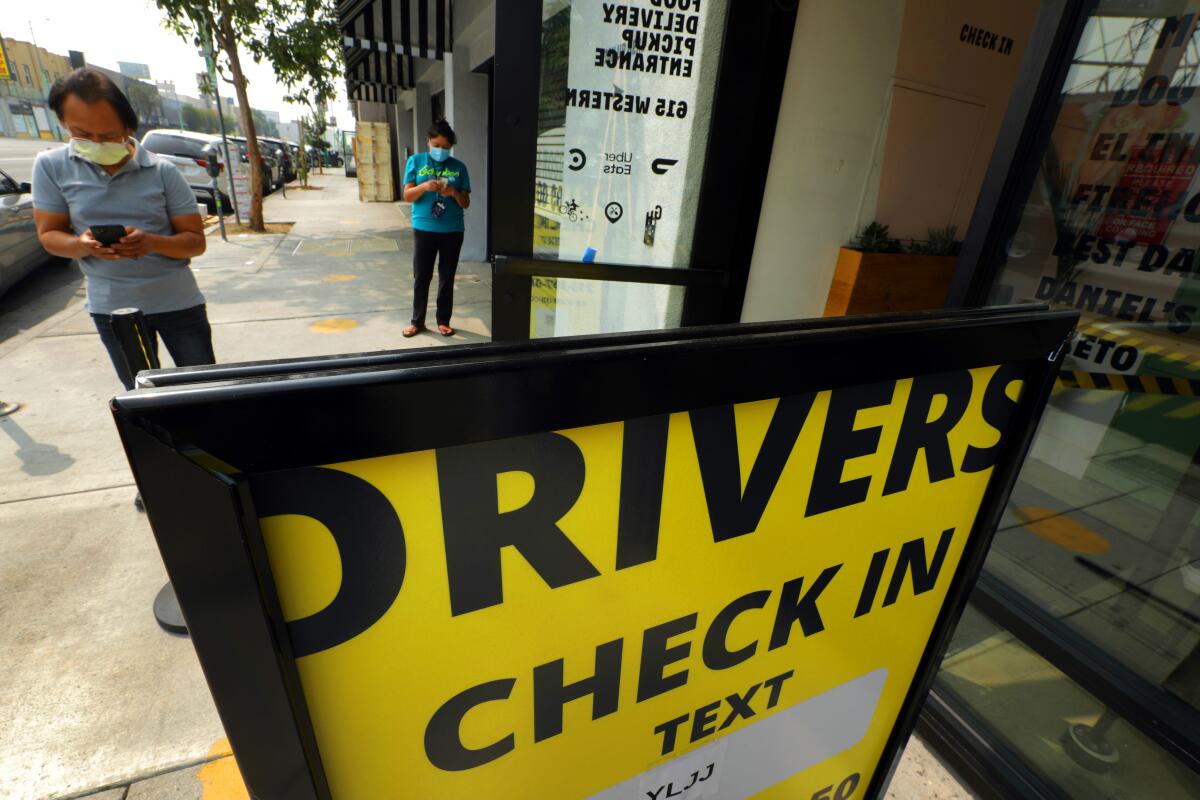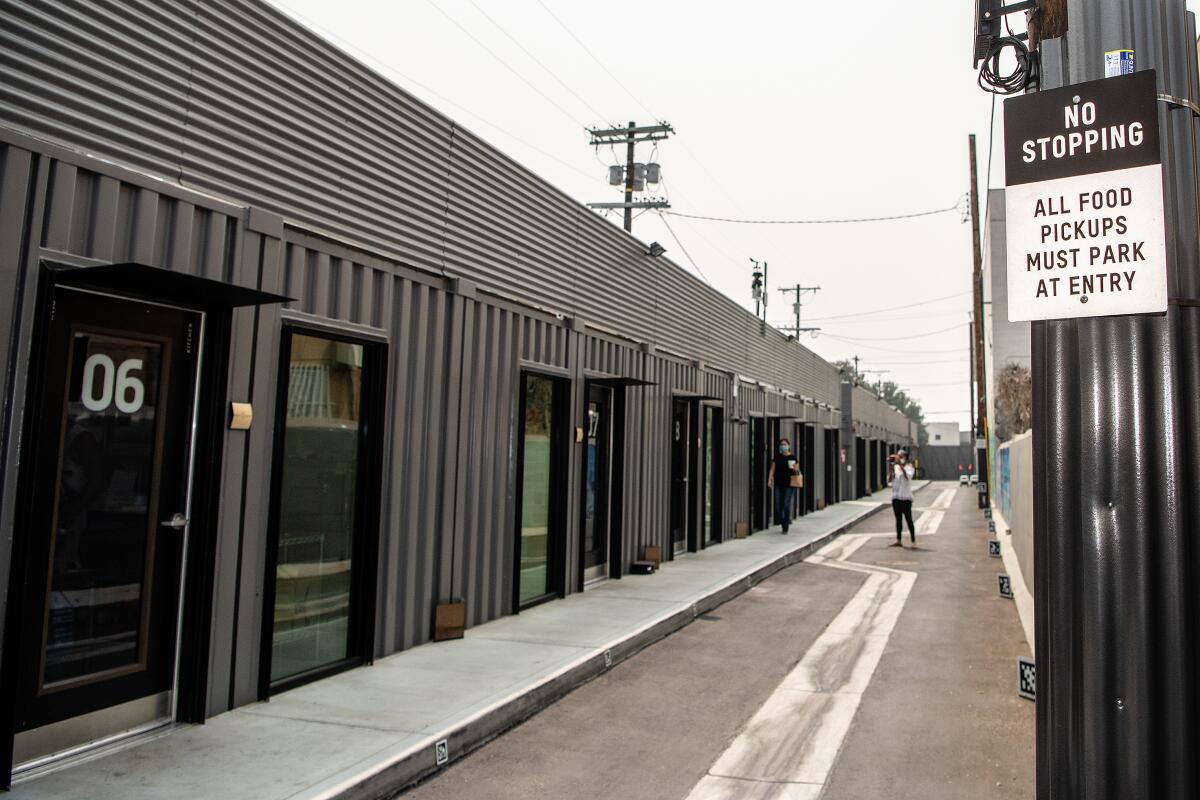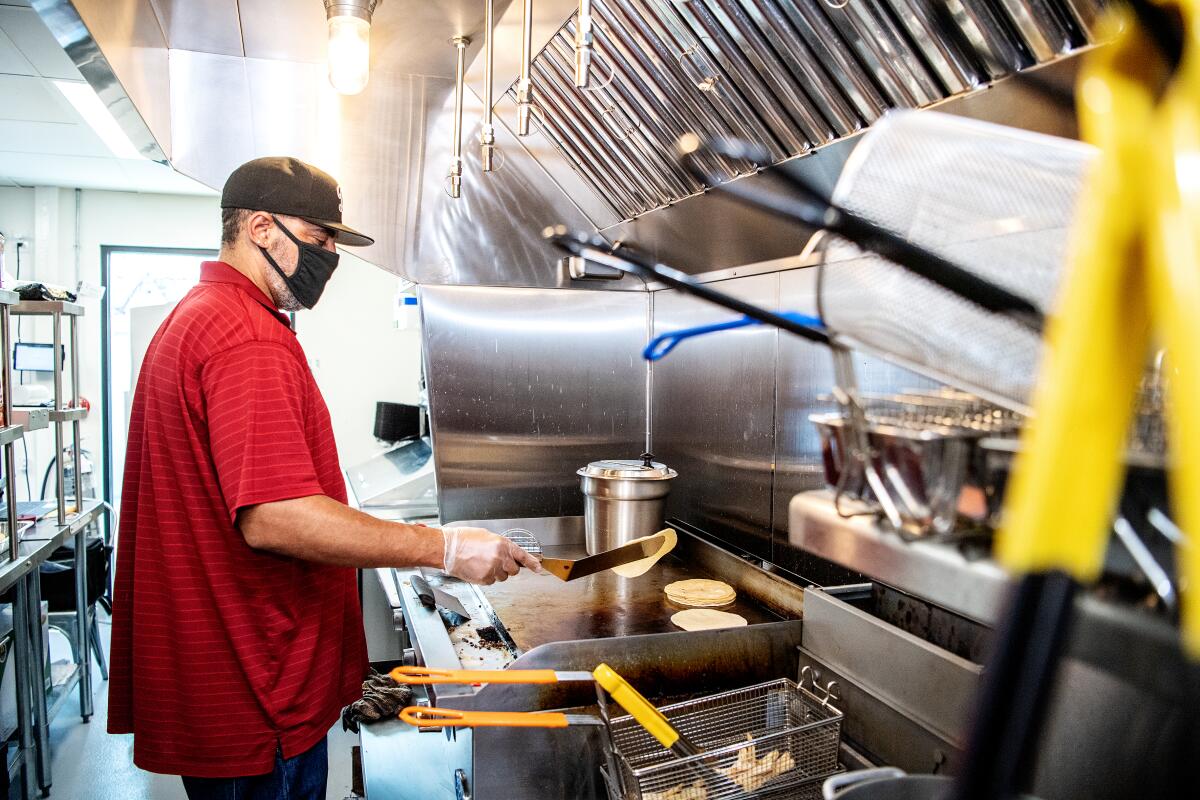Rise of the ghost kitchens: How virtual restaurants are reshaping L.A.’s dining economy

- Share via
It’s 11 p.m. on a weeknight and you’re hungry. Already in your pajamas, you unlock your smartphone and open a delivery app to scroll through a virtual buffet of options. One listing catches your eye: Fisher & Son’s Fish and Chips. Maybe you’ve never heard of the place, but the food, clearly displayed in enticing photos, looks solid. You add a two-piece fried cod with fries ($14.95) to your cart and hit order. A message pops up: DELIVERY ETA 25-40 MIN.
Meanwhile, at 801 N. Fairfax Ave., No. 105, a sign-less storefront beneath a block of modern-looking apartments, your fish and chips order pops onto a tablet screen with a loud ping. A cook working the line takes note and tosses a few filets and fries into the fryer while putting the finishing touches on two other orders — a roast beet and quinoa salad and a dozen mango habanero wings.
In a previous life, this kitchen space was home to Michael Cimarusti’s Cape Seafood and Provisions, a restaurant and market that closed in early 2019. But since late last year the tenant has been Byte to Bite Industries, a “market-leading virtual restaurant owner and operator” (according to its website) with locations in Hollywood, Beverly Hills, downtown and Long Beach.
Although they are not restaurants in the traditional sense, Byte to Bite locations prepare food for the 30 delivery-only brands the company owns or licenses, including Fisher & Son’s, Angel Wings, Burger Bitch, Morning After Breakfast, No Joke PB&J and Nacho Lords.
Whether you order your fish and chips from Fisher & Son’s or one of the company’s two other fried seafood concepts (Sunset Beach Fish and Chips and the Codfather), the same “two pieces of our famous ale-battered Pacific cod and crispy French fries served with tartar sauce” that each brand offers will be cooked in the same kitchen by the same crew. And that crew also will be tasked with preparing quinoa salads, mango habanero wings or whatever brand-specific orders appear on the tablet.
Across Los Angeles, these tech-enabled transactions occur each day with thousands of orders, hundreds of drivers, dozens of so-called “ghost kitchens” hidden in strip malls or freeway-adjacent industrial areas.
In a remarkably short span, L.A. has become a national epicenter for this booming business, one that has attracted billions in tech industry investment and, fueled by a restaurant-crippling pandemic, has the potential to fundamentally reshape the way we dine.
The ghost-kitchen economy, it would seem, is here to stay.

Even before COVID-19 arrived, food delivery apps had begun reshaping the restaurant industry. A growing number of people were ordering food to eat at home, and a significant portion of those sales were facilitated through apps.
In 2018, the financial research firm UBS projected that the global food delivery market would grow 13.5% annually for the foreseeable future — compared with 3% growth in the overall restaurant industry. And that was before the pandemic hit.
As demand for food delivery has skyrocketed, the definition of what constitutes a restaurant has become increasingly flexible. Renting space for a dining room? Waitstaff? Tables and chairs? Optional. The only requirement is a kitchen. Focused solely on fulfilling online orders, these ghost-kitchen restaurants market their food directly to delivery app users, leaving some customers largely unaware that their restaurant does not physically exist as a separate bricks-and-mortar facility.
One of the few experts chronicling the growth of this nascent industry is Matt Newberg, a tech industry veteran who in 2019 founded HNGRY, a media and event platform that seeks to examine “the impact of technology on our relationship with food.”
According to Newberg, there is no singular type of ghost kitchen, though there are several configurations that have become increasingly popular. The simplest are those that piggyback off a real-life restaurant, using existing kitchens to offer new cuisines or concepts available exclusively on delivery apps. (A bricks-and-mortar restaurant that specializes in French food, for example, might pull double duty as a delivery-only sandwich brand.)
“The idea of a ghost kitchen is really a paradox,” Newberg said, “because of course you can’t scale kitchen space the way Amazon scales servers, but that’s the way [tech companies] are approaching it.”
One example is Virtual Restaurant Consulting, a Los Angeles-based startup that partners with restaurateurs to launch “profitable takeout- and delivery-only restaurants in their existing kitchens in as little as 30 days,” according to the company’s website.

According to promotional materials released in March, a restaurant can purchase, for a monthly license fee of $249 and an 18% cut of sales for the first six months, a license to operate Two Hens — a VRC-owned all-day breakfast brand — out of its kitchen, with the company providing menu training programs, social media and web pages, and streamlined access to third-party delivery platforms.
“On top of rising costs, labor shortages, stifling regulations, and brutal competition, independent restaurants are facing a growing shift toward off-premises dining,” VRC senior partner Alan Moore said in a press release. “We allow restaurateurs to focus on cooking during the critical launch period of their new business, while we manage everything else.”
It’s not just consulting companies looking to expand. L.A. investors with little to no experience in the restaurant business have poured millions into the construction of shared kitchen spaces, which offer fully equipped and permitted food prep areas that businesses can lease and staff in exchange for monthly rent and a percentage of sales.
One of the first and largest of these companies is City Storage Systems, a Los Angeles-based startup cofounded by serial tech entrepreneur Diego Berdakin. According to business filings, the company focus involves “repurposing distressed real estate assets, such as parking lots or abandoned commercial buildings,” and turning them into facilities “suited for new industries such as online retail or food delivery.”
In 2015, Berdakin purchased a block-long, single-story warehouse in Pico-Union and spent the next two years outfitting the space with 27 kitchen units, each about 200 square feet. Situated across the street from a cemetery and scrawled with graffiti, the industrial warehouse didn’t appear attractive as a traditional restaurant space but proved a perfect fit for one of City Storage Systems’ subsidiaries, CloudKitchens.
A stone’s throw from Koreatown and downtown and easily accessible from the 10 and 101 freeways, the unmarked warehouse proved to be an ideal location for a commissary, allowing drivers to quickly and easily park and pick up delivery orders before shuttling them off to customers.
Soon CloudKitchens had filled its stalls with a dozen or so kitchens, with many licensing several of CloudKitchens’ in-house brands for an additional fee. This meant the warehouse could be home to as many as 100 virtual listings, including Skinny Bitch Pizza, the Steve Aoki-branded Pizzaoki and Made in Brooklyn NY Pizza.
Two years after CloudKitchens’ launch, Travis Kalanick, cofounder and former chief executive of Uber, bought a controlling interest in the company for $150 million, becoming its chief executive in early 2019. By the end of the year, the company had raised $400 million from Saudi Arabia’s sovereign wealth fund, an equity investment that valued CloudKitchens at about $5 billion, according to the Wall Street Journal. (CloudKitchens did not respond to a recent interview request.)
“The upside [of a CloudKitchens space] is that your time to market is short and the upfront cost is low,” said Noah Holton-Raphael, one of the co-owners of Ggiata, a Jersey-inspired Italian deli and CloudKitchens tenant.
Holton-Raphael, with childhood friends Max Bahramipour, Jack Welles and Jack Biebel, signed a month-to-month lease at CloudKitchens in June after shelving plans to launch Ggiata as a food truck. They estimate it took about $20,000 to open the deli as a delivery and takeout concept, which included hiring and training their own kitchen staff.

Having heavily invested in branding and the digital marketing, Ggiata was able to develop a sizable fan base for its sandwiches despite many customers being unaware that the “restaurant” was located inside a CloudKitchens commissary.
But despite growing sales, Welles and the rest of the owners said they chafed at certain aspects of the CloudKitchens arrangement, including requirements that tenants use the company’s proprietary software and have all orders handled by CloudKitchens staffers once they leave the kitchen.
“As a business owner, it can be frustrating when you can’t control the entire experience,” Holton-Raphael said, adding that they have immediate plans to relocate Ggiata to a bricks-and-mortar location.
Since launching in Pico-Union, CloudKitchens has expanded rapidly, opening ghost-kitchen commissaries in Koreatown, Long Beach, Anaheim and downtown. The company also has opened or acquired dozens of locations in cities across the country — Houston; Atlanta; San Diego; Chicago; Orlando, Fla.; Philadelphia, Oakland, Columbus, Ohio — with most strategically located next to college campuses or urban centers.
Competing facilities have cropped up as well.
There’s Kitchen United in Pasadena, located in a former Le Cordon Bleu cooking school and home to 20 kitchen spaces (filled by tenants such as El Tepeyac Cafe, the Halal Guys and Mama Musubi), and Colony, a West L.A. shared kitchen facility founded by two German real estate investors that houses 37 brands (including Trejo’s Tacos, Shin-Sen-Gumi and Oi Asian Fusion).
Unlike CloudKitchens facilities, which allow customers to pick up orders but are mainly geared toward delivery drivers, Kitchen United and the Colony have sought to cultivate the ambiance of a food court, installing outdoor seating, on-site ordering kiosks or drive-thru pickup windows.
During COVID-19, however, the compact footprints that make commissary facilities appealing for developers have also made them a liability. During peak orders times, drivers at some locations have reported issues with overcrowding at pickup counters (at a CloudKitchens facility near USC, drivers are instructed to wait in their cars after checking in), while cramped kitchen areas offer hazardously little room for workers to socially distance.
Even as demand for food delivery has increased dramatically since the closure of indoor dining (sales grew 174% year-over-year as of mid-August, according to a report by credit card analysis firm Cardlytics), companies such as CloudKitchens are facing new competition from vacant spaces that once housed traditional restaurants, another consequence of the pandemic.
That’s the case with the former Good Greek Grill restaurant space in Hollywood, now a commissary kitchen operated by Grubhub and the company behind Buca di Beppo in partnership with L.A. celebrity chef Eric Greenspan, an early adopter in the food delivery industry and former CloudKitchens partner. (The group recently launched Tyga Bites, a “celebrity-owned virtual dining concept” backed by the rapper Tyga.)

Or consider Spring, a lauded French fine dining spot in downtown Los Angeles that closed in 2018: What used to be a stunning, light-filled dining room currently acts as a staging area for a handful of delivery brands that are operated exclusively through Postmates and staffed by a local catering company known for cooking at corporate events for the likes of Nike and Spotify.
Less than a mile south, an Umami Burger location on Broadway is expanding its kitchen to prepare food for Krispy Rice and Sam’s Crispy Chicken, two delivery brands developed by SBE, Umami Burger’s parent company. With a goal of opening 200 ghost-kitchen locations nationwide by the end of 2021, SBE plans to take advantage of “underutilized” kitchen facilities at its entertainment and hotel properties, according to press materials.
Equipped with rivers of data provided by app users, tech-based delivery companies can home in on the demand for specific cuisines within geographic areas, even going as far as approaching struggling food businesses with branded concepts that can be tacked onto their existing menu with minimal effort.
“You create a marketplace, you learn from the marketplace, then you try to pick out things that you can execute better than what’s available,” Newberg said. “It’s the same way that Amazon and Netflix operate.”
But given the organizational complexity that makes up the ghost-kitchen economy, it’s fair to wonder how much money trickles down to individual restaurant owners.
Newberg said that tenant turnover at the ghost-kitchen commissaries remains consistently high, pointing to a Kitchen Fund report that showed the average ghost-kitchen operator needs to generate at least $650,000 in annual sales to break even (by comparison, he said, the average Chipotle store generates just under $400,000 annually from delivery and pickup).
In addition to the commission fees paid to third-party delivery apps (currently capped at 15% in Los Angeles), a ghost-kitchen tenant might be charged anywhere from 15% to 30% of its sales in addition to its monthly rent. And if you’re operating a food brand owned by someone else? Expect to pay around 15% of sales as a license fee. After subtracting food and labor costs, what remains is an increasing diminutive slice of the pie.
“The cost to entry isn’t as low as it seems. Sure, the up-front costs can be lower because there’s no physical storefront, but that’s also the main problem in the end,” Greenspan, the early adopter, told Thinknum Media in May. “If you have no storefront, you have no relationship with the customer. They don’t know the difference between you and anyone else on an app. You need a sign on the road.”
Aaron Jones, co-owner of Taco Pete in Compton, was originally drawn to CloudKitchens because it offered the chance to expand his family’s 50-year-old restaurant brand at “a fraction of the price” of opening a second location or paying $60,000 to lease a food truck.
Six months into his lease at a commissary space, Jones said he feels the ghost-kitchen model is more favorable for business with established names, at least when it comes to attracting enough customer attention to run a profitable business.
“If we didn’t have our original location, it’d probably be very difficult to make this work,” Jones said. “If you’re new to the business or if you’re a young chef trying to make a name for yourself, it’s really hard to get noticed.”
More to Read
Eat your way across L.A.
Get our weekly Tasting Notes newsletter for reviews, news and more.
You may occasionally receive promotional content from the Los Angeles Times.










